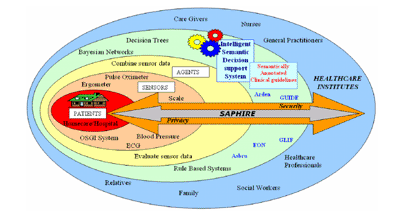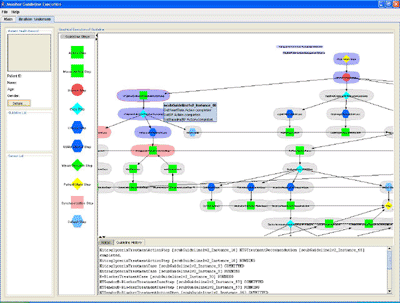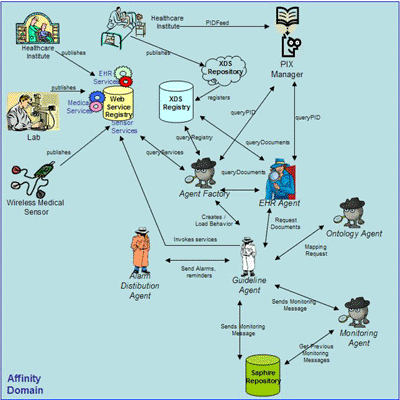The medical practitioners at all levels are becoming more overloaded as the aging population of Europe increases. The health services of the EU can claim considerable credit for the decline in mortality over the last thirty years. However this success, particularly the fall in mortality rates among older people, has increased the demand for healthcare. Furthermore, there are discrepancies in health status between the old and new member states. On the other hand, information technology, combined with recent advances in networking, mobile communications and wireless medical sensor technologies offers a great potential to support healthcare professionals and to deliver health care services at a distance hence providing the opportunities to improve healthcare.
An Intelligent Healthcare Monitoring and Decision Support System
The SAPHIRE Project [1] is developing an intelligent healthcare monitoring and decision support system on a platform integrating the wireless medical sensor data with hospital information systems to address the problem of an ever-increasing workload in medical fields due to the increasing percentage of elderly people. In this project, the patient monitoring is achieved by using agent technology where the "agent behaviour" is supported by intelligent decision support systems based on clinical practice guidelines. In the SAPHIRE system, patient history stored in medical information systems is accessed through semantically enriched Web services and IHE XDS Registry/Repository to tackle the interoperability problem. In this way, not only the observations received from wireless medical sensors but also the patient medical history is used in the reasoning process. The overall vision of the SAPHIRE project can be seen in Figure 1.

Figure 1 Overall vision of the SAPHIRE Project
Clinical Decision Support Systems in the Saphire Project
Clinical Decision Support Systems (CDSS) broadly refer to providing clinicians or patients with clinical knowledge and patient-related information, intelligently filtered and processed to enhance patient care. Recently, there has been an explosion in basic and clinical research on disease pathophysiology and treatment. Coupled with increased demands on healthcare delivery systems, this rapid growth has made the practice of medicine increasingly complex. The healthcare community response to this growing complexity has been to develop clinical practice guidelines to simplify and improve healthcare delivery. As an example, the National Guideline Clearinghouse⢠(NGC) [2] provides a comprehensive database of evidence-based clinical practice guidelines and related documents. Despite the widespread publication of clinical standards and practice guidelines, however, healthcare professionals have difficulties in understanding and applying these guidelines in the clinical care setting. This necessitates computerized decision support systems automating clinical guidelines to support the health professionals.
Guideline Interchange Format (GLIF) in Saphire
For this reason, Guideline Interchange Format (GLIF) [3] Version 3.4 is selected as the model for representing the Computerized Clinical Guidelines in SAPHIRE. GLIF is comprised of three levels of abstraction; first one is the conceptual flowchart of the guideline, the second one is the computable specification that can be verified for logical consistency and completeness and the third one is the implementable specification that can be incorporated into particular institutional information systems. However, GLIF 3 specifications leave the âimplementable levelâ open. Therefore, in order to have an implementable guideline definition referring to the several services necessary in SAPHIRE architecture, GLIF 3.4 is extended. A top-level layer named Medical Knowledge Layer has been added for this purpose. For all necessary services (Electronic Healthcare Records, Medical, and Sensor Services), there exists a class in the extended layer where these services are semantically annotated with ontologies. Moreover, there is an Alarm Entity class that is used for modelling the alarms that will be produced during the execution of guideline and delivered to doctors, nurses or patient relatives.

Figure 2. Saphire Guideline Execution Monitoring Tool
Interoperability Solutions in the Saphire Project
One of the major challenges in developing computerized decision support systems is accessing the many disparate data sources needed to retrieve patient-specific information. In the SAPHIRE project, the clinical decision support system that is incorporated into the system as an agent behaviour accesses patient medical history stored in medical information systems through semantically enriched Web services and IHE XDS Registry/Repository to tackle the interoperability problem. In this way, both the observations received as patientâs physiological signs data and the patient medical history are used in the reasoning process.
This is an essential component, because in clinical guidelines, the physiological signs received from wireless medical sensors, the patient care plan and medical history (such as previous diagnosis, medication list, allergy/adverse drug reactions) all affect the clinical path to be followed. More specifically the interoperability problem that needs to be addressed to develop an effective intelligent healthcare monitoring tool is as follows: the data coming from the wireless medical sensors are either in proprietary format (for example, for electrocardiogram data, Philips' XML ECG Data Format) or when it conforms to a standard, this still does not solve the interoperability problem since there are very many standards (again for electrocardiogram data, the available standards include: SCP-ECP, US Food and Drug Administration FDA/HL7 Annotated ECG, I-Med and ecgML). When integrating this data with electronic healthcare records, the problem gets more complex since hospital information systems are also mostly proprietary and when they conform to an interface standard, there are again very many standards (such as HL7v2.x, HL7v3 CDA, CEN ENV 13606 EHRExtract, openEHR Archetypes) and thus the standards do not achieve the aimed interoperability. Furthermore, interoperability of data coming from various wireless medical sensors is also essential to infer information by combining data coming from various sensors.
Semantically Enriched Web services for Accessing Medical Sensor Data
In the SAPHIRE platform, the interoperability problem is addressed by exposing the data coming from sensors as well as the data stored in medical information systems as semantically enriched Web services; that is, both the functionality and the messages of these Web services are annotated through standard based ontologies. In this way, the "functional interoperability" which allows different platforms to exchange information is solved by making use of Web services and the "semantic interoperability" is handled by using ontologies based on medical standards. Using ontologies allows different medical platforms to interoperate at the semantic level, since mappings and translations between ontologies can be defined. On the other hand, interoperability of various medical data coming from several sources is still incomplete because although the semantics of those data are clear by semantically enriched web services, their entities may use different coding schemes such as ICD10, UMLS, SNOMED CT or LOINC for representing clinical terminologies.
Ontology Agent for Semantic Mediation of Clinical Content
In order to overcome all these abovementioned interoperability problems, an Ontology Agent that is responsible of handling the semantic mediation of the clinical content used in SAPHIRE Architecture has been developed. The Ontology Agent complies with FIPA Ontology Service Specifications [4]. Other than handling the mapping of the parameters of Medical Web Services and Sensor Web Services, in the background it uses a Web service which queries the UMLS Metathesaurus [5] and maps terms in one coding scheme to a term in another coding scheme for mapping clinical terminologies. Such an interoperability mechanism then allows the development of the intelligent decision support system for monitoring the healthcare process.
IHE XDS for Sharing Electronic Healthcare Records (EHRs)
As a secondary mechanism for sharing the Electronic Healthcare Records (EHR) documents, an industry initiative called âIntegrating the Healthcare Enterprise (IHE) Cross Enterprise Document Sharing (XDS)" Profile [6] is used for sharing EHRs among different organizations. As the registry/repository architecture, the Open-source IHE-XDS implementation by NIST [7] is integrated to SAPHIRE architecture by implementing a client application. Through this client application the EHR documents represented as HL7 CDA [8] documents are published to the XDS registry through their metadata. The EHR registration, query and document retrieval mechanisms are all supported in SAPHIRE.
Asynchronous Web Services for Interacting with Clinical Workflows
While examining the guideline models that are used in SAPHIRE, it became clear that apart from accessing the EHR of the patients, sometimes it is necessary to interact with the clinical workflow running in hospital. For example, one of the guideline models can decide that "aspirin should be prescribed to the patient". For this type of interactions, Medical Web Services that store such medication and procedure orders to the available Hospital Information System. In addition to this, there are some steps where the guideline requests an operation such as angiography or an x-ray lab order and wishes to see the results. Since this may take time, these kinds of orders are implemented as Asynchronous Web Services. By this way, the guideline execution is not interrupted and when the results are ready, they are sent back to the guideline execution environment asynchronously.
An Agent-based Architecture
The SAPHIRE system continuously monitors the patients through dedicated agents and supports the healthcare professionals through intelligent decision support system. Apart from the alerts that are produced automatically by the wireless medical sensors, SAPHIRE system produces alarms by combining flow of data coming from medical sensors and medical summary of the patient and sends them to the related people. Guideline Agent, which is responsible of executing the computerized clinical guideline models, creates alarm messages and reminders to be sent to doctors, nurses or healthcare relatives and passes those messages to Alarm Distribution Agent. Alarm Distribution Agent is responsible of delivering these alarm messages to related people according to rules of emergency by means of email, SMS or instant messaging. Alarm Distribution Agent is also able to track successful delivery of the messages.

Figure 3. Saphire Agent-based Architecture
Handling Security and Privacy in the Saphire System
Creating such an information infrastructure requires safeguards to maintain security and privacy of patient data. Patient identification and medical records can not be disclosed indiscriminately and different healthcare providers have different access rights. The SAPHIRE Project is implementing comprehensive security and privacy mechanisms to complement the infrastructure proposed. While providing these confidentiality and privacy mechanisms, the EU directives 95/46/EC and 2002/58/EC1 presenting the general principles of processing of personal data, and in particular Recommendation R(97)5 of the Council of Europe discussing protection of medical data collected and processed automatically are taken into account.
The SAPHIRE project is being built upon the results of a European commission funded project, IST-1-002103 Artemis [9], which has developed a semantic Web service-based P2P Infrastructure for the Interoperability of Medical Information Systems. Artemis project enables the Healthcare Institutes to exchange Electronic Healthcare Records in interoperable manner through semantically enriched Web services and semantic mediation. The SAPHIRE project exploits these results by integrating the patient data collected through wireless medical sensor devices with the hospital information systems. This infrastructure constitutes the interoperability base for the intelligent healthcare monitoring system.
Pilot Applications of Saphire
The Saphire System will be validated with the help of two pilot applications; one in a hospital environment, the second will be a homecare application. During the pilot application developments, the applications will test the safety and the accuracy of the sensor data, the Alerts System, the accuracy of the history data from the electronic medical records and the recommendations generated by the system by correct interpretation and implementation of the guidelines. For each of the pilot applications, each patient will sign up an informed consent which is mandatory to participate at this project.
The end users of the project envisions that the system could not only reduce the workload in the hospital and out-patient departments, diminish probability of human error, but could also in future endure reduced medical costs by cutting down intensive care stay and complex diagnostic investigations or therapeutic approaches where these are not necessary, and lead to a reduction of medical costs by cutting down rehospitalisation procedures in future.
The Hospital Pilot Application
The purpose of the hospital application is to demonstrate that the SAPHIRE system developed can provide bedside intelligent monitoring in a wireless fashion and can also provide patient-specific computer-generated clinical decision in accordance to the latest European Cardiology Guidelines. The Emergency Hospital of Bucharest (Spitalul Clinic de Urgenţă Bucureşti, SCUB) will develop the hospital pilot application for treating patients with acute coronary syndromes.
The Homecare Pilot Application
The Homecare Pilot Application aims to test the intelligent intermittent home monitoring of patients through wireless sensors and to integrate the data from the sensors with the data from the electronic medical records in the system interoperability platform in order to generate alerts and recommendations via an intelligent Decision Support System based on a clinical guideline model. The rehabilitation department of the Schuechtermann-Schillersche Klinik Bad Rothenfelde (SSK) in cooperation with the Institute for Heart and Circulation Research at the University of Witten/Herdecke (IHKF) will develop the home pilot application. Patients suffering from ischemic heart disease followed by a revascularization therapy will be included into the pilot application. Such patients undergo a program for physiological recovery and training in secondary prevention. With the help of the SAPHIRE architecture, the Home Pilot Application will enable the responsible physician to supervise the physiological training as a basic issue in secondary prevention for a longer time than in the routinely applied rehabilitation program. Additionally the outpatient phase of the SAPHIRE-system is under better medical control than attainable by a routine post-rehabilitation phase of normal patients.
REFERENCES
[1]. SAPHIRE Project Web Page, http://www.srdc.metu.edu.tr/webpage/projects/saphire/
[2]. National Guideline Clearinghouse⢠(NGC), http://www.guideline.gov/
[3]. Guideline Interchange Format (GLIF), http://www.glif.org/
[4]. FIPA Ontology Service Specification, http://www.fipa.org/specs/fipa00086/XC00086C.html
[5]. UMLS Knowledge Source Server, http://umlsks.nlm.nih.gov/kss
[6]. XDS, IHE IT infrastructure technical framework, http://www.ihe.net/Technical Framework/upload/ihe_iti_tf _2.0_vol1 FT 2005-08-15.pdf
[7]. IHE-OS, Open-source IHE-XDS implementation, http://sourceforge.net/projects/iheos
[8]. HL7 Clinical Document Architecture,, Release 2.0, http://hl7.org/library/Committees/structure/
CDA.ReleaseTwo.Committee-Ballot03.Aug.2004.zip
[9]. Artemis in eHealthNews.eu Portal, http://www.ehealthnews.eu/content/view/216/27/
For further information, please visit:
http://www.srdc.metu.edu.tr/webpage/projects/saphire/